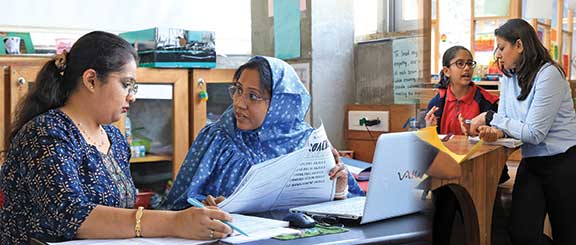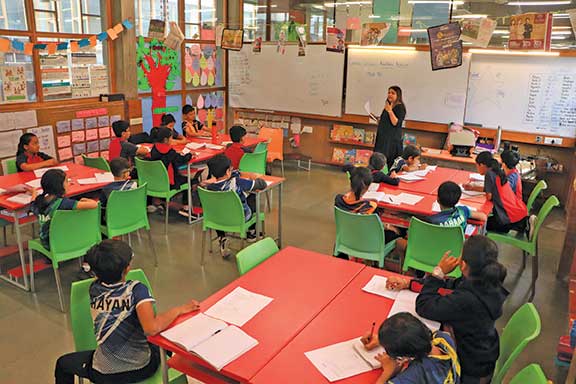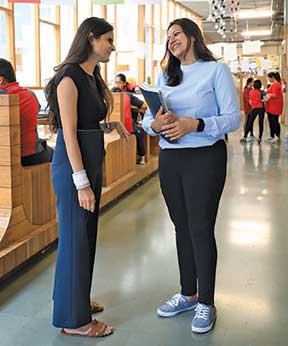Ankita Diwekar-Kabra
The staff room at a well-known progressive Central Board of Secondary Education (CBSE) school in North India was abuzz. The new principal had announced in a recent all-hands meeting about the teacher evaluation system that would be implemented from the current academic year. Just like the corporate sector, teachers would have a performance management system (PMS), which would include feedback from all stakeholders. The teacher’s salary increment would be decided based on their overall performance. This announcement evoked mixed reactions from the staff. Sudha Tyagi, a teacher close to her retirement said, “This is yet another example of modernization and corruption of a noble profession.” “I don’t mind being subjected to an evaluation. My students love me and I deliver results,” quipped Chitra Banerji. Richa Tandon, known to be a strict disciplinarian, was a bit nervous. “I get good results but don’t know what students will say about me.” Mahesh Shankar, the chemistry teacher wondered aloud, “Will we get salaries comparable to a corporate job if we are evaluated?” Overall, the news had made all the teachers think about the way they did their job. Down the corridor, the school head, Radhika Raje, sat for a brainstorming session in the conference room with her team of principals, coordinators, and grade leaders. While the governing board had mandated that a PMS needed to be implemented in line with the National Education Policy (NEP), there was no clear direction or road map. Implementing a PMS would need a culture change, a growth mindset and most importantly, time. How would they do it?

The imperative for change
NEP 2020 proposes a robust merit-based structure that motivates and incentivizes teachers to do their best. It is true that teachers need to be effective to help students achieve their potential. Various research studies have shown a strong link between the quality of teaching and academic performance of students. Hence, for students to succeed, it is imperative that teachers succeed and that there are systems and processes in place to assess teachers in a fair and objective manner. However, designing a teacher evaluation system is by no means an easy task. The first non-negotiable step is a commitment to such a system. The governing board/school owners/directors need to acknowledge the necessity of a PMS for teachers. School leaders are already overworked. Implementing a PMS would mean that a sizable amount of time would be spent by school heads, academic leaders, grade coordinators, program coordinators, team leaders, etc., in observing, assessing, and coaching teachers. There needs to be release time for them to do this. Having established the need and the time commitment for a PMS, let’s delve into one approach to effective implementation.
Just as the key criterion of a school bus driver is to drive safely, the primary role of a teacher is to teach effectively. A master teacher wears multiple hats. She* is a subject expert and can deliver the subject matter in an engaging way. She is well prepared for class. She is a compassionate mentor and treats her students with care, respect, and dignity. Her classes are well-managed. Hence, it is evident that the most important factor to gauge a teacher’s effectiveness is how they execute their core responsibility: effective teaching and nurturing a conducive classroom environment. It also is the trickiest and most time consuming to record, measure, and improve on. Triangulation of data or in other words, assessing through multiple channels is a good practice to be followed to capture feedback from all quarters. A teacher’s self-assessment, classroom observations by a school leader, and student feedback for the teacher all act as valuable tools.

Self-assessment: This is the least threatening and possibly the most effective tool for enhancing teacher effectiveness. Using a high-quality mobile phone on a stand or a video camera, a teacher can be filmed in class. Later, the teacher watches her own class recording. She identifies things that went well and areas that she could do better in. She submits her reflection to her school principal. Such a method encourages introspection and personal growth. “I didn’t realize I speak so fast.” “I notice that I gave the same student frequent chances to respond when I asked questions. I can be careful about this,” “I caught myself using the phrase ‘like you know’ several times while explaining a concept. I can avoid using such fillers,” are some reflections that came up when teachers at our school watched themselves in action. What better than the assessee herself identifying her strengths and areas that need improvement?
Classroom observations: Considering time constraints, most schools can manage an academic leader doing a classroom observation once or twice a year. This could be a planned or a surprise visit. In case of a surprise visit, school leaders must be mindful of the fact that even the best teachers can have a bad day. So, a single class observation cannot be the basis of judging a teacher. Some questions to keep in mind when conducting a classroom observation are:
• Is the teacher well-prepared for class in terms of content and resources?
• Are her instructions explicit?
• Does she use questioning strategies effectively?
• Is her language positive and polite?
• Does she manage student behaviour that disrupts classes effectively?
• Do students look engaged?
Following any classroom observation, it’s essential to conduct a debriefing meeting. In this session, the assessor can provide constructive feedback to the teacher, highlighting both ‘glows’ (aspects of teaching that were particularly effective) and ‘grows’ (areas where there is potential for improvement).
Other than observing a full teaching period, leaders can also engage in what are called as “trust-based observations” (TBO). Regular or frequent classroom observations (just popping in and out of the class for a few minutes) and reflective conversations form the basis of TBOs. TBOs are designed to be less fear-based and more trust-based. Reflective conversation is the secret sauce that makes these kinds of observations effective – informal, quick five-minute chats, where the leader affirms the teacher’s strength and offers a few suggestions. Most importantly, such conversations establish a relationship of trust and psychological safety between the teacher and the principal. The teacher feels less intimidated to see school authorities on rounds and feels safe to take risks in the classroom with her teaching methodology.
Feedback from students serves as a crucial data point, offering valuable insights into the teacher’s effectiveness. Using open-ended questions for older students, a smiley system or a yes/no/maybe system for younger students helps to capture feedback about the teacher’s effectiveness. For the early years, parent feedback could also be considered as a data point as most young children share about their school day at home.
Some questions that could be asked in a student feedback form include:
- Do you enjoy the teacher’s class?
- Do you understand what she teaches you?
- Does she motivate you to do your best?
- Is the teacher fair towards all students?
While analyzing student feedback, the assessor should keep in mind that this is a “point in time” feedback. Factors like recency influence the answers in such a feedback questionnaire either positively or negatively.

While “effective teaching and nurturing a conducive classroom environment” would be the most important criterion in a PMS, there are other factors that should also be considered. Teamwork and professionalism is one such criterion reflecting a teacher’s overall contribution to the school environment. Immediate colleagues/co-workers/team members teaching the same grade or subject can provide valuable insights about a teacher. Some questions to ask them would be:
• Is the teacher a good team player?
• Does she synergize with her colleagues?
• Does she meet deadlines?
• Does she receive (and give) feedback from/to her co-workers?
• Does she follow the organizational code of conduct?
• Is she mindful about using leaves?
Such responses can be collected in anonymous forms when the system is implemented initially. Over a period of time, as the community matures and gets used to a growth mindset, teachers can be coached and empowered to give feedback to each other on an ongoing basis.
Another important factor to consider in the PMS is how much does the teacher engage in professional development? Does she take these learnings back to class? Does she demonstrate a learning disposition? However, it is quite challenging for an assessor to check on this unless they see it very evidently. Hence, while “professional development and implementation” can be a criterion, it is difficult to measure effectively.
Together, these three criteria can capture the performance of a teacher effectively:
- Effective teaching and nurturing a conducive classroom environment
- Teamwork and professionalism
- Professional development and implementation

The data collected for these criteria can be recorded for each teacher and used to make a professional judgment about the teacher’s performance. At our school, we mark each of these criteria on a scale of 1 to 4 where 1 is poor and 4 is excellent. A fixed percentage to each criterion gives us a final rating for the teacher. This is then mapped to salary increment slabs where people with a rating of 3 or 4 are given a higher increment than teachers who are rated a 1 or 2. A teacher who is ranked 1 probably needs to be given strong feedback and put on a performance improvement plan so that they can improve their overall effectiveness.
Does such a system work? I would say it works fairly well. It does well to recognize and reward outstanding teachers and helps to provide a supportive environment for struggling teachers. Is it 100% accurate and fair? Unfortunately, no. Recency effect, halo/horn effect, in-group bias or in-group favouritism are amongst the commonest cognitive biases that such a system is vulnerable to. Here, multiple data points (multiple observations by multiple assessors, feedback collected from students and colleagues two to three times in a year) help minimize the subjectivity of the process. Another roadblock to implementing a PMS is staff preparedness. The manner in which leaders communicate and set the expectations for the process plays a pivotal role. It’s essential for them to convey that a single observation won’t drastically alter a teacher’s appraisal. They need to effectively assure the staff that the overarching goal is to cultivate a collegial and professional work culture. Robust and clear communication from the top is crucial in this regard. Thirdly, leaders need to be trained to observe classes, give feedback, and record observations. At the end of the day, a somewhat effective PMS with its imperfections is still better than no teacher evaluation at all. A system where increments are a fixed percentage and purely offered on seniority fails to offer any real motivation for teachers to excel.
My advice to Radhika Raje and her team would be to start with committing to the PMS process. Start with baby steps. It will take a couple of years to get it going and a couple more years to get it right. But over a period of time, if implemented with integrity, objectivity, and fidelity, the PMS process will cultivate a growth mindset in the teaching community and bring rewards in line with efforts and performance. Teachers will thrive in a culture where they feel trusted, empowered, and safe. Students will have a voice in giving feedback, teachers will be motivated to do their best and the school’s trust index in the parent community will soar! A winning proposition for all stakeholders.
*Throughout this note ‘she’ denotes both genders and should be read as ‘he or she’, unless the context specifically requires otherwise.
The author is the co-founder of Fountainhead School in Surat. She is widely recognized as a pioneer in the fields of early childhood, primary, and secondary education. Her dedication and expertise have garnered her numerous awards, cementing her status as an award-winning educator and leader. Beyond her educational endeavors, Ankita is deeply passionate about personal development, yoga, Vedanta, travel, and reading. She can be reached at ankita.kabra@fountainheadschools.org.
Related Articles
